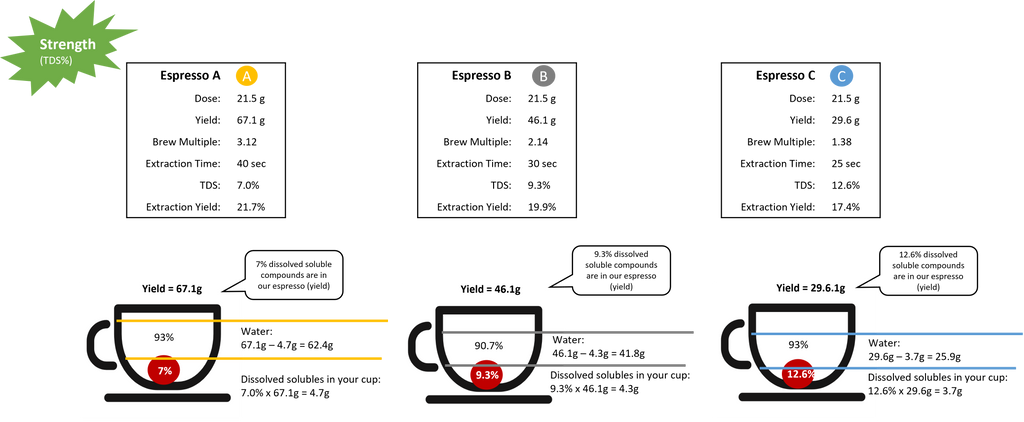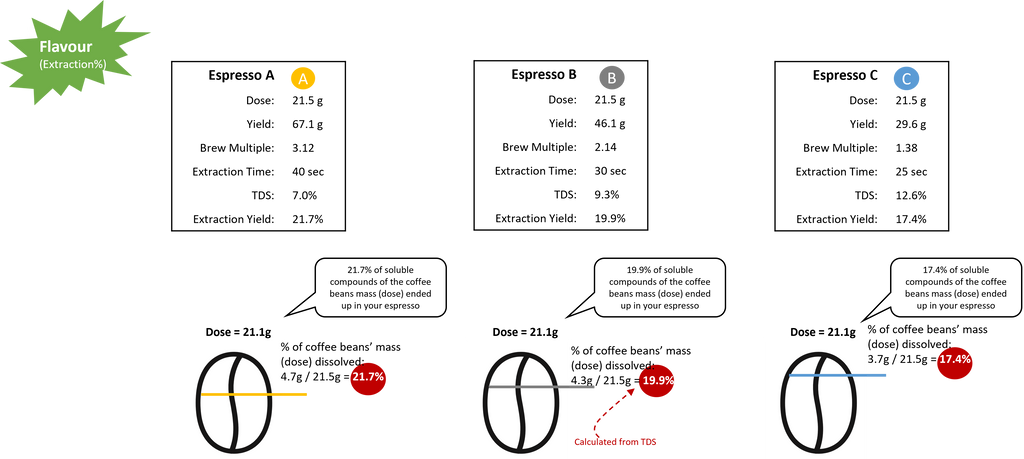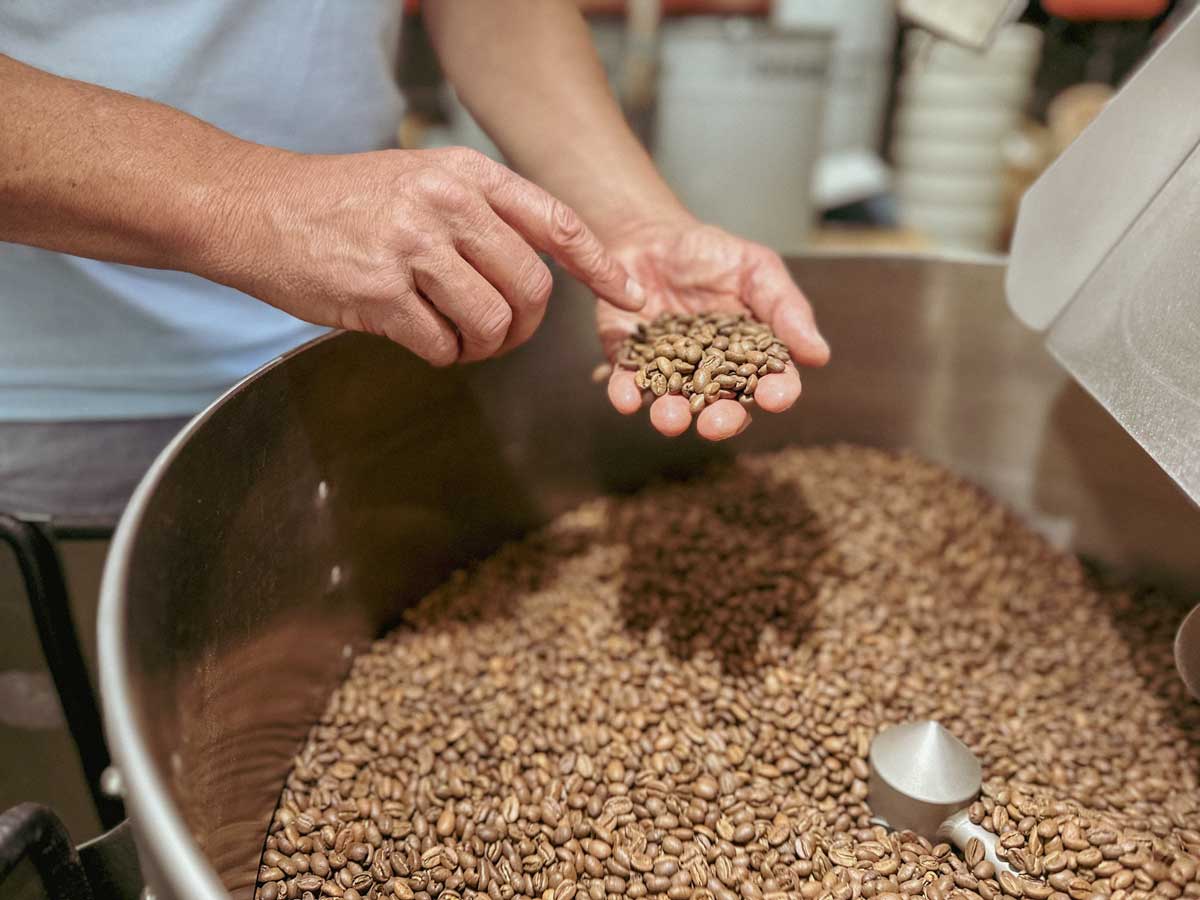.. or the art of coffee extraction
In this blog we are exploring the concepts of strength and flavour. If you are new to espresso making and are really after a simple 'how to' espresso making guide, please head to ‘How to make a perfect espresso at home’. There you'll find easy-peasy instructions how to get started. If you are hooked and want to dive deeper into the science of espresso making, keep on reading. Let’s get stuck in.
Centuries ago, humankind discovered that when pouring hot water over roasted ground coffee it turns into a tasty brew – our coffee. Since then we have been perfecting how to get the tasty bits from our roasted coffee. This process is called coffee extraction.
By understanding how extraction works, we can control what ends up in our cup. Let’s explore this a bit further.
What happens throughout coffee extraction?
Coffee extraction can be simply described as the process during which water infuses the roasted ground coffee and passes all the tasty (and sometimes not so tasty) bits into our cup. Only soluble compounds in a coffee bean can be dissolved by water. You can think of water as a solvent freeing the soluble compounds from the coffee bean structure by dissolving them. Some of the main solubles in coffee are caffeine, acids, lipids, melanoidins sugars and plant fibres.
Now, not all the mass of the coffee bean is soluble when it comes in contact with water. Only an estimated 30% are soluble and of that 30 % only 2/3 are considered good solubles, so the tasty bits we want to extract.
What are soluble compounds in your coffee and why should you care?
Solubles are extracted at different times during the extraction process. Fortunately, the ‘bad’ solubles, the not so tasty ones, take a longer time to dissolve and therefore are released last.

- The sour taste in coffee is caused by the coffee’s acids. Acids are easily soluble by water and are therefore dissolved first.
- The mouthfeel we experience when drinking coffee is largely attributed to lipids. Different brewing methods will give you different mouthfeel. For example, making an espresso or a plunger coffee (French press) lipids easily pass through into your cup. However, when brewing a pour-over coffee for example with a V60, the finer pores of the filter paper prevents the lipids from passing through and your experience of the mouthfeel will be very different. Did you know, lipids are also creating the gorgeous crema in espressos.
- Melanoidins, which are created throughout the Maillard reaction during the roasting process, are primarily responsible for the nutty, malty, chocolatey, and even fruity flavours and largely the coffee’s brown colour in the roasted coffee bean and the cup.
- Sugars are more complex compounds than acids and require more energy to dissolve and are passed through later in our coffee extraction. In our coffee they contribute to the coffee’s perceived sweetness.
- And finally, some of the plant fibres are broken down attributing to earthy and bitter flavours in the cup.
- Most of the caffeine is dissolved in the early part of the extraction process and contributes to perceived strength and some bitterness in the coffee.
How can you measure and control the tasty components in the right mix?
Your taste buds are a pretty good indicator of the quality of your coffee extraction. But what determines if you enjoyed a coffee or not? Apart from the company you keep, when deciding if we enjoyed a brew, we assess, if we liked the flavours and experienced strength in the coffee.
So, how can you measure flavour and strength? Strength is measured by ‘TDS %’ (= Total Soluble Solids) and flavour by ‘extraction %’.
Let’s explore those measures.
Measuring strength: TDS
What actually is strength? The sensation of strength gives you the experience of mouthfeel or thickness (viscosity) of our coffee. With higher strength, you also perceive a higher intensity of flavours.
Strength can be measured by its TDS levels. TDS stands for ‘Total Dissolved Solids’ and tells you the percentage of dissolved soluble compounds in your brew.
For example, a TDS reading of 9.5% means your total brew contains 9.5% of dissolved soluble compounds and 90.5% water. TDS helps you to measure the strength of those solubles in your cup. It plays a vital role in how we perceive the coffee.
The most common way to measure TDS is using a refractometer. A refractometer is a clever little device that measures the degree to which light is refracted by the liquid. Some refractometers come with an app to help you analyse the data from your coffee extraction.
In our example below, we show you how to measure TDS and analyse your data without the use of an app. This will help you in mastering the art of coffee extraction.
What TDS level should you aim for?
If you are after strength, you want to aim for a high TDS level at which the coffee still tastes good. TDS levels vary by brewing method:
- TDS levels for espresso extraction typically range between 8% - 12%.
- TDS levels for a ristretto are more than 12 %. So it is just a stronger espresso.
- TDS levels for a lungo are something between 2-8 %. So an espresso with a higher brew multiple.
- TDS levels for a filter are between 1.15% - 1.35%
To better illustrate the concept of TDS, let’s have a closer look at three espresso shots. All three espressos have the same dose, same grind setting, however varying yields and extraction times:

With lower brew multiples (yield as a multiple of dose), you can observe an increase in strength as measured in TDS%. This means, strength moves opposite to brew multiples.
How to increase the strength of your brew?
You can try one of two strategies:
- Strategy 1: Keep your brew multiples constant and grind your coffee finer. This means you create a larger surface area for the water to dissolve those soluble compounds. By grinding finer, you will need to increase the extraction time for the water to pass through the coffee.
- Strategy 2: Decrease your brew multiples. Reduce your extraction time and simply run less water through your coffee. Keep your grind setting constant.
Measuring the quality of the extracted flavours: Extraction Yield
So far we talked about measuring strength. Strength is only one dimension we are after in our cup. We are also chasing flavours!!! How do you measure flavour apart from relying on your taste buds?
You can assess the quality of the extracted flavours by calculating the extraction level:
Extraction % = TDS % x Brew Multiple = TDS % x Yield / Dose
The extraction % tells us, the percentage of the coffee beans’ mass that was dissolved by water. Remember, a maximum of about 30% of the mass of the coffee beans is soluble.
Let’s be clear, extraction levels won’t tell you if your brew has strawberry notes. It tells you though if you extracted enough soluble compounds to create a balanced cup.
What extraction yield should you aim for?
- For espresso’s an optimal extraction is between 18 – 21%. This means 18% - 21% of solubles of the coffee bean’s mass ended up in the cup. For other brewing methods, the range is between 18% - 22% according to the SCAA
- An extraction below 18% is considered under-extracted. Some of the desirable components have not been sufficiently extracted and you may experience sour and sharp notes to your brew. Remember the first solubles extracted in your brew are acids, which taste sour. Acids in fact can taste quite pleasing if balanced off. Think of a lemon tart. It tastes delicious because the sour notes are balanced with sweetness.
- Extractions of over 21% are considered over-extracted and have a more bitter taste. Too many solubles have been dissolved – the good and the bad ones. The bitterness in coffee takes longer to develop than the sour and sweet flavours but can quickly dominate the overall taste of our brew.
Let’s continue with the example of our three espressos. Using a refractometer, we established our TDS %, which measures the strength of the espresso shots. Based on those TDS readings we can now calculate the extraction %, which gives us an indication if we are under-extracted or over-extracted flavours or if we nailed it:

Larger brew multiples extract more solubles and have a higher extraction %. Both measurements move in the same direction. By increasing brew multiples you extract more flavours. Be careful though not to move too far on to the right of the x-axis as you may dissolve too many of those less desirable bitter flavours.
How to extract more flavours?
You can try one of two strategies:
- Strategy 1: Keep your brew multiples constant and grind your coffee finer. This means you create a larger surface area for the water to dissolve those soluble compounds. By grinding finer, you will need to increase the extraction time for the water to pass through the coffee.
- Strategy 2: Increase your brew multiple. Larger brew multiples extract more solubles and have a higher extraction %. By increasing your brew multiple you extract more flavours. Be careful though not to dissolve too many of those less desirable bitter flavours.
Happy brewing!







